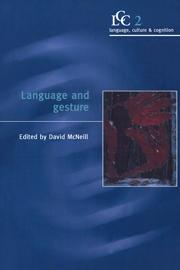Book contents
- Frontmatter
- Contents
- Acknowledgments
- Introduction
- Part 1 Gesture in action
- 1 Pointing, gesture spaces, and mental maps
- 2 Language and gesture: unity or duality?
- 3 The influence of addressee location on spatial language and representational gestures of direction
- 4 Gesture, aphasia, and interaction
- 5 Gestural interaction between the instructor and the learner in origami instruction
- 6 Gestures, knowledge, and the world
- Part 2 Gesture in thought
- Part 3 Modeling gesture performance
- Part 4 From gesture to sign
- Index
2 - Language and gesture: unity or duality?
Published online by Cambridge University Press: 07 January 2010
- Frontmatter
- Contents
- Acknowledgments
- Introduction
- Part 1 Gesture in action
- 1 Pointing, gesture spaces, and mental maps
- 2 Language and gesture: unity or duality?
- 3 The influence of addressee location on spatial language and representational gestures of direction
- 4 Gesture, aphasia, and interaction
- 5 Gestural interaction between the instructor and the learner in origami instruction
- 6 Gestures, knowledge, and the world
- Part 2 Gesture in thought
- Part 3 Modeling gesture performance
- Part 4 From gesture to sign
- Index
Summary
Introduction
‘Language’ and ‘gesture’ have long been held to be different, yet at the same time a relationship between them has always been recognized. However, whether they are regarded as belonging together or not depends upon how these words are defined. Thus if, with Armstrong, Stokoe & Wilcox, we accept Studdert-Kennedy's (1987: 77) definition of ‘gesture’ as “an equivalence class of coordinated movements that achieve some end” (see Armstrong et al. 1995: 43), then, insofar as both speech and, let us say, gestures of the hands are comprised of “coordinated movements that achieve some end,” it is possible to argue for a fundamental identity between the one and the other, as indeed they have done. On the other hand, if we insist, as some have, that a defining feature of language is that it be spoken, then this seems forever to make it impossible to see ‘gesture’ as part of ‘language’. However, if we define language in a more abstract fashion, and allow that its medium of realization is not one of its defining features, then whether or not ‘gesture’ is to be seen as a part of language depends upon what other features are insisted upon. For example, if we follow Saussure's definition of language, so long as ‘gestures’ can be shown to be arbitrary form-meaning pairs differentiated in contrastive relationships and organized paradigmatically and syntagmatically, they can be regarded as a form of language. On these grounds, gesture systems such as primary or alternate sign languages would be included, but we might exclude such modes of expression as improvised or locally created gesturings such as may be observed in many of the gestures used concurrently with speech.
- Type
- Chapter
- Information
- Language and Gesture , pp. 47 - 63Publisher: Cambridge University PressPrint publication year: 2000
- 130
- Cited by



